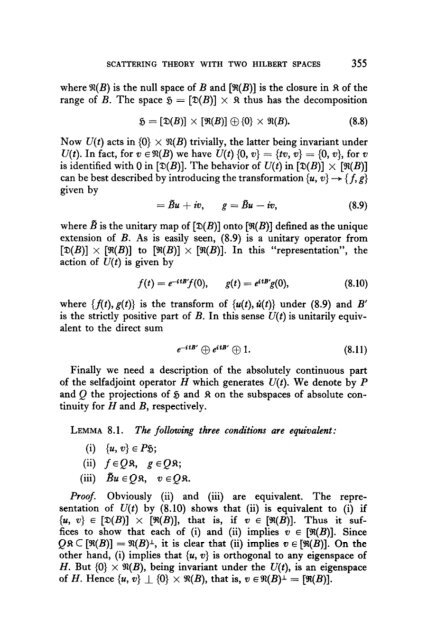On the Characters and the Plancherel Formula of Nilpotent Groups ...
On the Characters and the Plancherel Formula of Nilpotent Groups ...
On the Characters and the Plancherel Formula of Nilpotent Groups ...
You also want an ePaper? Increase the reach of your titles
YUMPU automatically turns print PDFs into web optimized ePapers that Google loves.
SCATTERING THEORY WITH TWO HILBERT SPACES 355<br />
where X(B) is <strong>the</strong> null space <strong>of</strong> B <strong>and</strong> [s(B)] is <strong>the</strong> closure in R <strong>of</strong> <strong>the</strong><br />
range <strong>of</strong> B. The space .$J = [D(B)] x R thus has <strong>the</strong> decomposition<br />
sj = [W>l x Pv910 @I x WV (8.8)<br />
Now U(t) acts in {0} x ‘S(B) trivially, <strong>the</strong> latter being invariant under<br />
U(t). In fact, for z, E%(B) we have U(t) (0, ZJ> = {ta, w} = (0, a), for v<br />
is identified with 0 in [a(B)]. The behavior <strong>of</strong> U(t) in [D(B)] x [S(B)]<br />
can be best described by introducing <strong>the</strong> transformation {u, w} --f {f, g}<br />
given by<br />
= Bu + iw, g = Bu - iw, (8.9)<br />
where B is <strong>the</strong> unitary map <strong>of</strong> [D(B)] onto [S(B)] defined as <strong>the</strong> unique<br />
extension <strong>of</strong> B. As is easily seen, (8.9) is a unitary operator from<br />
[D(B)] x [S(B)] to [R(B)] x [X(B)]. In this “representation”, <strong>the</strong><br />
action <strong>of</strong> U(t) is given by<br />
f(t) = e-itBy(0), g(t) = eitB’g(0), (8.10)<br />
where {f(t), g(t)) is <strong>the</strong> transform <strong>of</strong> {u(t),ii(t)) under (8.9) <strong>and</strong> B’<br />
is <strong>the</strong> strictly positive part <strong>of</strong> B. In this sense U(t) is unitarily equiv-<br />
alent to <strong>the</strong> direct sum<br />
e-itB’ @ eitB’ @ 1. (8.11)<br />
Finally we need a description <strong>of</strong> <strong>the</strong> absolutely continuous part<br />
<strong>of</strong> <strong>the</strong> selfadjoint operator H which generates U(t). We denote by P<br />
<strong>and</strong> Q <strong>the</strong> projections <strong>of</strong> 8 <strong>and</strong> Jt on <strong>the</strong> subspaces <strong>of</strong> absolute con-<br />
tinuity for H <strong>and</strong> B, respectively.<br />
LEMMA 8.1. The following three conditions are equiwalent:<br />
(i) {u, w} E Psj;<br />
(ii) fEQ% gEQ%<br />
(iii) Bu E QR, w EQR.<br />
Pro<strong>of</strong>. Obviously (ii) <strong>and</strong> (iii) are equivalent. The representation<br />
<strong>of</strong> U(t) by (8.10) s h ows that (ii) is equivalent to (i) if<br />
1% 4 E Pv31 x [S(B)], that is, if w E [X(B)]. Thus it suf-<br />
fices to show that each <strong>of</strong> (i) <strong>and</strong> (ii) implies w E [S(B)]. Since<br />
Qst C [X(B)] = S(B)‘-, 1 ‘t is clear that (ii) implies w E [g(B)]. <strong>On</strong> <strong>the</strong><br />
o<strong>the</strong>r h<strong>and</strong>, (i) implies that {u, w} is orthogonal to any eigenspace <strong>of</strong><br />
H. But {0} x 92(B), being invariant under <strong>the</strong> U(t), is an eigenspace<br />
<strong>of</strong> H. Hence {u, w} 1 {O] x g(B), that is, w ER(B)I = [X(B)].

















